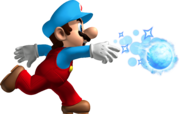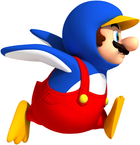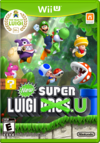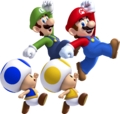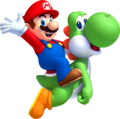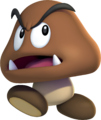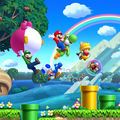New Super Mario Bros. U: Difference between revisions
Tags: Mobile edit Advanced mobile edit |
m (→Blocks) Tags: Mobile edit Advanced mobile edit |
||
| Line 1,382: | Line 1,382: | ||
|image9=[[File:Music-block.png|50px]] | |image9=[[File:Music-block.png|50px]] | ||
|name9=[[Note Block|Jump Block]] | |name9=[[Note Block|Jump Block]] | ||
|description9=A block that | |description9=A block that makes Mario jump higher when he jumps or steps on it. | ||
|image10=[[File:NSMBW POW Block Artwork.png|50px]] | |image10=[[File:NSMBW POW Block Artwork.png|50px]] | ||
|name10=[[POW Block]] | |name10=[[POW Block]] | ||
Revision as of 08:24, August 1, 2024
- This article is about the 2012 Wii U game. For the Nintendo Switch port of this game, see New Super Mario Bros. U Deluxe. For the microgame from WarioWare: Get It Together!, see New Super Mario Bros. U (microgame).
| New Super Mario Bros. U | |||||||||||
|---|---|---|---|---|---|---|---|---|---|---|---|
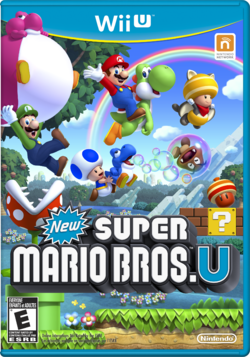 North American box cover For alternate box art, see the game's gallery. | |||||||||||
| Developer | Nintendo EAD | ||||||||||
| Publisher | Nintendo | ||||||||||
| Platform(s) | Wii U | ||||||||||
| Release date | Template:Release[?] | ||||||||||
| Language(s) | English (United Kingdom) English (United States) French (France) French (Canada) German Spanish (Spain) Spanish (Latin America) Italian Dutch Portuguese (Portugal) Russian Japanese | ||||||||||
| Genre | Platformer | ||||||||||
| Rating(s) |
| ||||||||||
| Mode(s) | Single-player Multiplayer | ||||||||||
| Format | Wii U: | ||||||||||
| Input | Wii U: | ||||||||||
| Serial code(s) | WUP-ARPE-USA (U.S.) | ||||||||||
New Super Mario Bros. U is a 2012 side-scrolling 2.5D platforming game, and a launch title for the Wii U. It is the sixteenth entry in the Super Mario series[1] and the fourth New Super Mario Bros. game. As a sequel to New Super Mario Bros. Wii, the game is a follow-up to New Super Mario Bros. 2. It is the first Super Mario series game to be released as a launch title for a home console since Super Mario 64. An expansion pack for this game was later released in mid-2013, titled New Super Luigi U.
Based upon the New Super Mario Bros. Mii tech demo shown at E3 2011, the game uses new, more detailed background styles and models and introduces the Flying Squirrel power-up, acquired by Mario and his friends from an item called the Super Acorn, as well as utilizing the Wii U GamePad in Boost Mode.
The game was originally purchasable at the Nintendo eShop, requiring 2301.7 MB (approx. 2.25 GB) to be downloaded, but with the retail release of New Super Mario Bros. U + New Super Luigi U, it is no longer possible to purchase New Super Mario Bros. U as a standalone game in regions outside of Japan.
A port titled New Super Mario Bros. U Deluxe was released for the Nintendo Switch in January 2019, and once again contains both New Super Mario Bros. U and New Super Luigi U.
Story
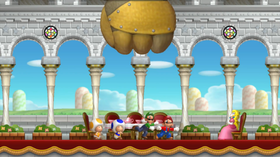
Mario, Luigi, Yellow Toad, and Blue Toad are with Princess Peach in Peach's Castle dining together. Bowser and the Koopalings suddenly arrive in their Airships, with the former sporting a Mecha Hand that smashes and launches the brothers and the Toads away from the castle. Mario and his friends crash into the Acorn Tree, launching Super Acorns through the area. They then tumble out of the tree, passing by a Bubble Baby Yoshi and Balloon Baby Yoshi, and they then look into the horizon to see Bowser beginning a siege on Princess Peach's Castle, setting the Mario Bros. and the Toads to go on a new adventure and to save Princess Peach.
As the game progresses, the view occasionally shifts to Peach's Castle, showing the flags being replaced by Bowser's flags (after Tilted Tunnel), and the castle being surrounded by a thin tornado-like cloud that is made thicker by Magikoopa's magic (after Stoneslide Tower), entirely obscuring the castle (after Giant Skewer Tower or Freezing-Rain Tower). Mario, Luigi, Yellow Toad, and Blue Toad also encounter Bowser's forces, including the Koopalings, Boom Boom, Magikoopa, and Bowser Jr., who occasionally attacks the heroes with his father's airship. All of them are defeated, and Bowser Jr. causes the airship to crash after making the mechanical hand punch through it. After reaching Peach's Castle and defeating Bowser, the group moves onward, but Bowser Jr. appears and urges Magikoopa to spread his magic across the area. After heading to the castle exterior, Mario and the others see Peach in a tower. Before they can save her, she is locked inside the tower and Bowser appears, now at a giant size, alongside Bowser Jr. Eventually, Bowser is defeated and Bowser Jr., embarrassed, flees. The character that defeated Bowser gets to Peach and bows down to her, and is then kissed by her, to their shock and delight, as the clouds surrounding the castle disappear, restoring it to its former state.
Outside the castle, the Koopalings and Bowser Jr. are fleeing on the airship as Bowser, who has returned to his normal size, recovers. Noticing the escaping airship, he climbs up onto one of the castle towers and leaps onto the ship, but his weight causes it to plummet into a hill nearby; they then fly away hanging onto Bowser Jr.'s Junior Clown Car while Mario and Blue Toad watch. They then turn back to the others, who are celebrating their victory, with Mario delivering a final victory pose.
Gameplay
Overview
New Super Mario Bros. U is a platform game which plays very similarly to that of past New Super Mario Bros. games, especially New Super Mario Bros. Wii, with the return of the 4-player multiplayer functioning identically to the Wii game, while most of the elements and design found in the game make heavy reference to Super Mario World. Many other gameplay elements from the Wii game, such as the Super Guide, Enemy Courses, and the bubble function, also return. In certain modes, players can play as their Miis, including the first player, who can also choose whoever to play as. Power-ups, like the Fire Flower, Ice Flower, Penguin Suit, Propeller Mushroom, and the Mini Mushroom return. The game also features a new power-up, the Super Acorn, which gives Mario and co. a Flying Squirrel form, which lets them glide and grab on to walls.
New Super Mario Bros. U features two main controller options: single player using the Wii U GamePad, and single-player or multiplayer using Wii Remotes and/or Wii U Pro Controllers; the player can switch controllers at any point between the GamePad and a Wii Remote or Pro Controller by pausing the game, either in a level or on the world map, and selecting the "Change Controller" option. The game supports up to five simultaneous players, with up to four being able to play as the characters with a Wii Remote or Wii U Pro Controller, and are able to drop in and out at any point while in a stage by pressing ![]() on the GamePad and selecting a character, or on the map by pausing and selecting "Number of Players". Another player is able to use the Wii U GamePad in what is known as Boost Mode. In Boost Mode, the GamePad player can assist the other players by placing blocks for them to stand on and stunning enemies. Boost Mode can be used at any point when playing with one of the other controllers; when playing with just the GamePad, it supports Off-TV Play.
on the GamePad and selecting a character, or on the map by pausing and selecting "Number of Players". Another player is able to use the Wii U GamePad in what is known as Boost Mode. In Boost Mode, the GamePad player can assist the other players by placing blocks for them to stand on and stunning enemies. Boost Mode can be used at any point when playing with one of the other controllers; when playing with just the GamePad, it supports Off-TV Play.
After clearing Layer-Cake Desert-1, an enemy called Nabbit appears and steals an item from a Toad House connecting that level, heading back to Acorn Plains-1. When the player enters a stage with Nabbit, the objective is to race him to the goal, trying to catch him before he can get away. If the player succeeds in catching Nabbit, they are rewarded with a P-Acorn. Replacing the Toad saving in New Super Mario Bros. Wii, Nabbit only appears in one stage in the first seven worlds.
The first update to the game added Miiverse support. With Miiverse functionality enabled, players can read each others' posts on the world map by viewing the map; when not viewing the map a Miiverse post is indicated by a red balloon, generally near a stage, and can be hidden by pressing ![]() ; when on the World Map while using Boost Mode, the GamePad player can scroll across the map on the GamePad screen and view Miiverse posts. At certain times throughout gameplay, such as when the player dies several times or reaches the end of a course in a specific way (collecting all the Star Coins, clearing in a certain amount of time, clearing without taking damage, etc.), they are given a prompt to post a message to Miiverse. Players can also see Miiverse posts after they die in a stage. Miiverse settings can be changed at any point on the world map by selecting the pencil and envelope icon on the bottom right of the pause menu.
; when on the World Map while using Boost Mode, the GamePad player can scroll across the map on the GamePad screen and view Miiverse posts. At certain times throughout gameplay, such as when the player dies several times or reaches the end of a course in a specific way (collecting all the Star Coins, clearing in a certain amount of time, clearing without taking damage, etc.), they are given a prompt to post a message to Miiverse. Players can also see Miiverse posts after they die in a stage. Miiverse settings can be changed at any point on the world map by selecting the pencil and envelope icon on the bottom right of the pause menu.
The sound is in stereo, with no support for 5.1 surround.
Controls
Like New Super Mario Bros. Wii, the Wii Remote is the primary controller for the game, allowing players to shake the controller to perform a Spin Jump, dismount Yoshi, and pick up objects. However, players can also play the game normally with the Wii U GamePad (single-player only) or the Wii U Pro Controller (after the 1.3.0 update). In the case of the Wii U Pro Controller, actions that require motion control on the Wii Remote and Wii U GamePad are replaced with button pressing, as the Wii U Pro Controller lacks motion controls.
Unlike New Super Mario Bros. Wii, this game lacks Nunchuk support.
Stages
| Action(s) | Wii U GamePad | Wii U Pro Controller | Wii Remote |
|---|---|---|---|
| Move, swim (Baby Yoshi) | |||
| Jump, swim, glide (hold), wall jump, Flutter Jump (Yoshi; hold), double/triple jump (press right upon landing) | Option 1: Option 2: |
||
| Run, carry objects (hold); shoot fireballs/iceballs, extend tongue (Yoshi) | Option 1: Option 2: |
||
| Ground Pound (normal, simultaneous*) | Jump + |
||
| Crouch, slide (on slopes) | |||
| Climb (on fences, ladders, poles) | |||
| Bubble* | N/A | ||
| Enter door/Warp Pipe | Door: Pipe: |
Door: Pipe: | |
| Spin Jump, Baby Yoshi abilities, dismount Yoshi, Flying Squirrel jump, spin underwater (Baby Yoshi) | |||
| Grab other players*/frozen enemies | Run + (release run button to throw) |
Run + (release run button to throw) |
(release |
| Tilt Tilt Lifts | Tilt GamePad | Alternate between pressing |
Tilt Wii Remote |
| Pause | |||
| Boost Mode* | N/A | ||
* Multiplayer only.
| Action(s) | Wii U GamePad/Pro Controller | Wii Remote |
|---|---|---|
| Move, select option | ||
| Open inventory | ||
| View map | ||
| Pause | ||
| Zoom in/out (map view) | ||
| Confirm, hide/show Miiverse posts (map view) | ||
| Back | ||
Yoshis
Green Yoshis make a return, acting like in New Super Mario Bros Wii. Green is the only color available for Yoshis that the players ride on, unlike New Super Mario Bros. Wii. Yoshi now has a meter that tracks how many fruits he eats, instead of showing a number each time he eats one. As usual, eating 5 makes him lay an egg containing an item. Like in New Super Mario Bros. Wii, Yoshi cannot leave the courses that he appears in.
New Super Mario Bros. U also features the return of Baby Yoshis, having been absent from the Super Mario series since their debut in Super Mario World. The game features three differently-colored Baby Yoshis, each one with a special ability. They differ from the adult Green Yoshi in terms of gameplay. Being babies, they cannot be ridden, so characters must carry them throughout the levels. Baby Yoshis also instantly eat almost any enemy that is in front of them. Unlike in Super Mario World, however, Baby Yoshis no longer grow into adults after eating several enemies, instead remaining as babies. Two types of Baby Yoshis found on the overworld can be taken into any course, with the exception of Fortresses, Airships, and Castles.
| Baby Yoshi | Description |
|---|---|
 Bubble Baby Yoshi |
Blue Baby Yoshis that blow bubbles from their mouths. Enemies caught in these bubbles will turn into 3 Coins, a power-up or a 1-Up Mushroom. These bubbles can also be used as miniature platforms. They first appear on the Frosted Glacier map area. |
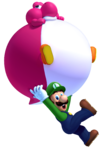 Balloon Baby Yoshi |
Magenta Baby Yoshis that expand like balloons and gently float in the air. These Baby Yoshis are similar to the Blimp Yoshi power-up, found in Super Mario Galaxy 2. They first appear on the Acorn Plains map area. Additionally, up to 4 players can grab on to one Baby Yoshi, by grabbing their legs. This slows the player down though. |
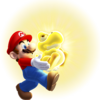 Glowing Baby Yoshi |
Yellow Baby Yoshis that light up dark areas and can stun enemies with their light attack. These Baby Yoshis act similar to the Light Blocks, found in New Super Mario Bros. Wii, and also Bulb Yoshi from Super Mario Galaxy 2. Unlike the other two Baby Yoshis, the Glowing Baby Yoshis are not found on the world map, and are only found in courses such as Perilous Pokey Cave. Instead of following the characters throughout the courses, they give an extra life when reach the end of the levels that they appear in. |
Inventory
The world map inventory, seen in Super Mario Bros. 3 and New Super Mario Bros. Wii, returns in New Super Mario Bros. U, allowing players to store items that can be used before entering a level. Unlike the other inventories, this is limited to ten items only. If more items come in, the player will have to discard items from the inventory until they have ten. Players can gain items into their inventory by playing Red Toad House minigames, collecting items on the world map itself, completing an Enemy Course, catching Nabbit, or finishing a level with the final two digits of the time matching.
Extra modes
In addition to the main adventure, New Super Mario Bros. U features three additional bonus modes to play. The first of these is Challenge Mode, in which players must complete a given objective on a given stage, some within a specific time limit. In most cases, after the player completes a challenge, they are ranked with a medal depending on how well they did. There are five types of challenges: Time Attack, Coin Collection, 1-Up Rally, Special, and Boost Mode.
Another mode is Boost Rush Mode, where players have to reach the end of two or three selected stages in the lowest possible time, similar to the Coin Rush mode featured in New Super Mario Bros. 2. Unlike Coin Rush, the stages scroll automatically, meaning the player has to keep up with the stage, which speeds up every time they collect coins.
Coin Battle from New Super Mario Bros. Wii is also available. However, in this version of the mode, players can be grouped into teams against each other or play free-for-all, rather than just the latter. The Wii U GamePad can also be used for Coin Edit, in which the GamePad is used to customize the coin placement in the Coin Battle-exclusive courses.
Unlike in the main game, player 1 can choose any character in these modes.
Worlds
Unlike the previous New Super Mario Bros. titles, where worlds are separated like in Super Mario Bros. 3, New Super Mario Bros. U has a contiguous world map, similar to Super Mario World. Like New Super Mario Bros. Wii, the worlds include Toad Houses and Enemy Courses, though only red and green Toad Houses return. Also returning are Towers, Castles, and Ghost House-related levels. The music changes instruments throughout the world map similar to Yoshi's Island.
This is the first 2D Super Mario game to use completely unique names for each of its levels, and the second after Super Mario World to name its greater areas in-game. Both games use food and beverages as the theme for their world names.
| Worlds | |||||
|---|---|---|---|---|---|
| Acorn Plains | Layer-Cake Desert | Sparkling Waters | |||

|
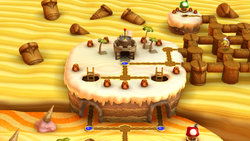
|
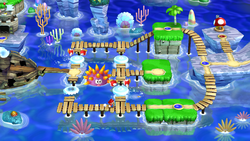
| |||
| A grassy world with plenty of shrubs, slanted mountains, and the Acorn Tree. This world is similar to many other first worlds in the Super Mario series. | A desert dotted with melting ice creams, giant cakes, and a sea of sand with Moai-like statues. | A chain of tropical islands and sea stacks, similar to World 4 from New Super Mario Bros. Wii. This world can be entirely skipped for Frosted Glacier. | |||
| # | Level | # | Level | # | Level |
| 1 | Acorn Plains Way (Grass) | 1 | Stone-Eye Zone (Desert) | 1 | Waterspout Beach (Beach) |
| 2 | Tilted Tunnel (Cave) | 2 | Perilous Pokey Cave (Desert/Cave) | 2 | Tropical Refresher (Underwater) |
| Crushing-Cogs Tower (Tower) | 3 | Fire Snake Cavern (Desert/Cave) | Giant Skewer Tower (Tower) | ||
| 3 | Yoshi Hill (Grass) | Stoneslide Tower (Tower/Desert) | Haunted Shipwreck (Shipwreck) | ||
| 4 | Mushroom Heights (Sky) | 4 | Spike's Spouting Sands (Desert) | 3 | Above the Cheep Cheep Seas (Beach/Sky) |
| 5 | Rise of the Piranha Plants (Grass) | 5 | Dry Desert Mushrooms (Desert/Sky) | 4 | Urchin Shoals (beach) |
| Lemmy's Swingback Castle (Castle) | 6 | Blooming Lakitus (Desert) | 5 | Dragoneel's Undersea Grotto (Underwater) | |
| Blooper's Secret Lair (Underwater/Cave) | Morton's Compactor Castle (Castle) | Larry's Torpedo Castle (Castle/Water) | |||
| Piranha Plants on Ice (snow) | Skyward Stalk (sky) | ||||
| Frosted Glacier | Soda Jungle | Rock-Candy Mines | |||

|
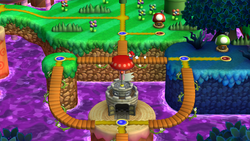 |
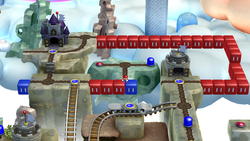
| |||
| A snowy mountain set at night, filled with stars and constellations. This world can be entirely skipped for Sparkling Waters. | A rainforest flooded by purple poison, based on the Forest of Illusion from Super Mario World and World 4 from New Super Mario Bros. | A rocky region with tall, holey mountains. Several red and blue switches similar to ! Switches appear in this world, and pressing them activates Stretch Blocks with their corresponding color. | |||
| # | Level | # | Level | # | Level |
| 1 | Spinning-Star Sky (Snow) | The Mighty Cannonship (Airship) | 1 | Fuzzy Clifftop (Mountain) | |
| 2 | Cooligan Fields (Snow) | 1 | Jungle of the Giants (Jungle) | 2 | Porcupuffer Falls (Mountain/Water) |
| Freezing-Rain Tower (Tower/Snow) | 2 | Bridge over Poisoned Waters (jungle) | Grinding-Stone Tower (Tower) | ||
| 3 | Prickly Goombas! (Snow) | 3 | Bramball Woods (Darkness Jungle) | 3 | Waddlewing's Nest (Mountain) |
| 4 | Scaling the Mountainside (Snow) | Snake Block Tower (Tower) | 4 | Light Blocks, Dark Tower (Cave) | |
| 5 | Icicle Caverns (Snow/Cave) | Which-Way Labyrinth (Ghost house) | 5 | Walking Piranha Plants! (Mountain) | |
| Swaying Ghost House (Ghost House) | 4 | Painted Swampland (Haunted forest/Painting) | 6 | Thrilling Spine Coaster (Cave) | |
| Wendy's Shifting Castle (Castle/Snow) | 5 | Deepsea Ruins (Underwater/Cave) | Screwtop Tower (tower) | ||
| Fliprus Lake (Snow) | 6 | Seesaw Bridge (Jungle) | 7 | Shifting-Floor Cave (Cave) | |
| 7 | Wiggler Stampede (Jungle) | Roy's Conveyor Castle (Castle) | |||
| Iggy's Volcanic Castle (Castle) | |||||
| Flight of the Para-Beetles (sky) | |||||
| Meringue Clouds | Peach's Castle | Superstar Road | |||

|
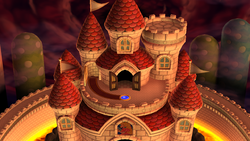
|
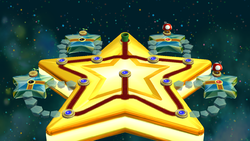
| |||
| A world above the clouds. Two levels take place at sunset, and this world's Castle takes place near the tornado surrounding the next world, as marked by different cloud coloration. | Peach's domain, initially in its welcoming usual state but slowly transformed into a lava-based area by Bowser. This world must be completed to beat the game. | A secret world unlocked after beating Bowser's final battle. Its levels must be unlocked with the Star Coins collected from all the levels of the previous worlds. | |||
| # | Level | # | Level | # | Level |
| 1 | Land of Flying Blocks (sky) | 1 | Meteor Moat (volcano/castle exterior) | 1 | Spine-Tingling Spine Coaster (grass) |
| 2 | Seesaw Shrooms (sky) | 2 | Magma-River Cruise (volcano/castle exterior) | 2 | Run for It (desert/sky) |
| 3 | Switchback Hill (sky) | 3 | Rising Tides of Lava (volcano/cave) | 3 | Swim for Your Life! (underwater/cave) |
| Slide Lift Tower (tower) | 4 | Firefall Cliffs (volcano/castle exterior) | 4 | Hammerswing Caverns (snow/cave) | |
| Spinning Spirit House (ghost house) | Red-Hot Elevator Ride (castle) | 5 | Spinning Platforms of Doom (haunted forest/painting) | ||
| 4 | Bouncy Cloud Boomerangs (sky) | The Final Battle (castle) | 6 | Fire Bar Cliffs (mountain) | |
| 5 | A Quick Dip in the Sky (sky) | 7 | Lakitu! Lakitu! Lakitu! (sky) | ||
| 6 | Snaking above Mist Valley (sky) | 8 | Pendulum Castle (fortress) | ||
| Ludwig's Clockwork Castle (castle/sky) | 9 | Follow That Shell! (sky) | |||
| Boarding the Airship (airship) | |||||
Other areas
| Secret Island | Coin Courses | |
|---|---|---|

|
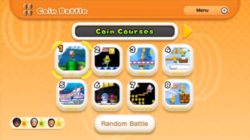
| |
| A small island between Acorn Plains and Sparkling Waters that houses a Purple Toad House, where the player can check several records. It is unlocked alongside Superstar Road. | A multiplayer-exclusive world found in Coin Battle, similar to World Coin from New Super Mario Bros. Wii. | |
| # | Difficulty | |
| World |
★ | |
| World |
★ | |
| World |
★★ | |
| World |
★★★ | |
| World |
★★★ | |
| World |
★★★★ | |
| World |
★★★★★ | |
| World |
★★★★★ | |
Characters
Playable
Luigi (multiplayer only)
Yellow Toad (multiplayer only)
Blue Toad (multiplayer only)
Mii (Coin Battle, Boost Rush, and Challenge Mode only)
Supporting
Princess Peach and Toads
Transformations
(starting form) |
( |
(New, |
( |
( |
( |
( |
(New, |
( |
( |
Enemies and obstacles
Enemies and obstacles with an asterisk (*) first appeared in New Super Mario Bros. Wii. The only two enemies that do not reappear are the Ghost Vase and the Bull's-Eye Bomber Bill.
Enemies
New enemies
| Image | Name | Description | First level | Last level
|
|---|---|---|---|---|
 |
Bowser Stunner | An electric statue that resembles Bowser's head and carries electrical currents. | Red-Hot Elevator Ride | Red-Hot Elevator Ride |
 |
Dragoneel | A long eel that attacks Mario by chasing him. Shorter, purple ones also exist that move slower, but make sharper turns. | Dragoneel's Undersea Grotto (red/purple) | Dragoneel's Undersea Grotto (red/purple) |
 |
Fliprus | A walrus-like creature that throws snowballs that can be jumped on. | Fliprus Lake | Fliprus Lake |
 |
Goombrat | A Goomba that resembles a persimmon and turns at ledges. | Mushroom Heights | Mushroom Heights |
 |
Grrrol | Round, Thwomp-like enemies that roll on the ground, replacing Spike Balls. | Stoneslide Tower | Grinding-Stone Tower |
 |
Mega Grrrol | A bigger Grrrol with the same behavior. | Grinding-Stone Tower | Grinding-Stone Tower |
 |
Mecha Cheep | Robotic Cheep Cheeps that are immune to fireballs. | The Mighty Cannonship | The Mighty Cannonship |
 |
Nabbit | A character that steals items from the map and must be defeated to retrieve the items. | Acorn Plains Way | Seesaw Shrooms |
 |
Piranha Pod | A projectile thrown by a Lakitu that turns into a Piranha Plant. | Blooming Lakitus | Blooming Lakitus |
| Targeting Ted | Red Torpedo Teds that home into their target, much like Missile Bills. | The Mighty Cannonship | The Mighty Cannonship | |
 |
Waddlewing | Orange flying-squirrel enemies that glide through stages. | Acorn Plains Way | Land of Flying Blocks |
Returning enemies
| Image | Name | Description | First level | Last level
|
|---|---|---|---|---|
 |
Amp | Electric balls that shock Mario upon contact. | Snake Block Tower | Ludwig's Clockwork Castle |
 |
Big Amp | Larger variants of Amps. | Snake Block Tower | Snake Block Tower |
| Blooper | Underwater enemies that move in an erratic pattern and follow Mario. | Blooper's Secret Lair | Tropical Refresher | |
 |
Blooper Baby | Small Bloopers that follow Blooper Nannies. | Blooper's Secret Lair | Blooper's Secret Lair |
 |
Blooper Nanny | Bloopers that have Blooper Babies swimming in a trail behind them. | Blooper's Secret Lair | Blooper's Secret Lair |
 |
Bob-omb | Bombs that ignite when jumped on or hit by a fireball before exploding shortly after. | Light Blocks, Dark Tower | The Final Battle |
 |
Parabomb | Parachuting Bob-ombs that are sometimes shot out of cannons. | Red-Hot Elevator Ride | Red-Hot Elevator Ride |
 |
Boo | Ghosts that chase the player only when his back is turned; they hide their face when the player looks at them. | Haunted Shipwreck | Spinning Spirit House |
| Circling Boo Buddies | Boos that fly in a circle formation. | Haunted Shipwreck | Spinning Platforms of Doom | |
 |
Broozer | A walking, boxing Boo. Can break bricks and other blocks that are normally indestructible. The player can defeat it by jumping on it three times or hitting him with a fireball. | Which-Way Labyrinth | Spinning Spirit House |
 |
Big Boo | Bigger variants of Boos that have the same behavior. | Swaying Ghost House | Spinning Spirit House |
 |
Bramball* | An enemy that moves around in a set pattern and is mostly covered in spikes, with the head being the only safe part to jump on. It can be forced to move if jumped into from below. | Bramball Woods | Bramball Woods |
 |
Bulber* | An enemy that illuminates a dark area and swims in a set pattern. | Deepsea Ruins | Deepsea Ruins |
 |
Bullet Bill | Bullets that fly straight forward and are shot from Bill Blasters and Bill Blaster Turrets. | Scaling the Mountainside | Switchback Hill |
 |
Missile Bill | Bullet Bills that target the player. | Roy's Conveyor Castle | Roy's Conveyor Castle |
| Torpedo Ted | A slow-moving torpedo that flies in one direction. | Larry's Torpedo Castle | The Mighty Cannonship | |
 |
Banzai Bill | Large Bullet Bills that fly straight forward. | Scaling the Mountainside | Scaling the Mountainside |
 |
King Bill* | A nearly invincible enemy that charges forward, taking up most of the screen. | Flight of the Para-Beetles | Flight of the Para-Beetles |
| Chain Chomp | Enemies tied to posts that lunge at Mario. If Mario ground pounds their post, they are set free. | Waddlewing's Nest | Waddlewing's Nest | |
 |
Cheep Cheep | Fish that are found swimming aimlessly in underwater levels. | Waterspout Beach | Swim for Your Life! |
 |
Eep Cheep* | A Cheep Cheep that lives in a school with other Eep Cheeps and swims away when the player comes near it. | Dragoneel's Undersea Grotto | Dragoneel's Undersea Grotto |
 |
Spiny Cheep Cheep | Fast-swimming fish that chase the player. | Tropical Refresher | Swim for Your Life! |
 |
Fish Bone | Skeletal fish that charge towards Mario. | Haunted Shipwreck | Deepsea Ruins |
 |
Big Cheep Cheep | Large variants of Cheep Cheeps that are found in underwater levels. | Tropical Refresher | Tropical Refresher |
 |
Cheep Chomp | Large fish that attempt to eat the player. | Swim for Your Life! | Swim for Your Life! |
 |
Porcupuffer | Fish that chase the player and jump out of the water. | Porcupuffer Falls | Porcupuffer Falls |
| Cooligan* | An enemy that slides on ice and slows down when hit. | Cooligan Fields | Cooligan Fields | |
 |
Fire Snake | Flames that jump in a high arc. | Fire Snake Cavern | Fire Snake Cavern |
 |
Flame Chomp | Black spheres that spit fireballs at the player. They explode after they run out of fireballs. | Rising Tides of Lava | Rising Tides of Lava |
 |
Foo* | An enemy that obscures the player's view by creating fog. | Snaking above Mist Valley | Snaking above Mist Valley |
 |
Fuzzy | Enemies that follow tracks and hurt the player upon contact. | Fuzzy Clifftop | A Quick Dip in the Sky |
 |
Big Fuzzy* | Large variants of Fuzzies. | Spine-Tingling Spine Coaster | Spine-Tingling Spine Coaster |
 |
Ghost Block* | A ? Block that floats and charges at the player, breaking if it hits a floor or a platform. | Haunted Shipwreck | Spinning Spirit House |
 |
Giant Clam | Clams that open and close their mouths. | Waterspout Beach | Waterspout Beach |
  |
Goomba | Common enemies that can be defeated by jumping on them. Some Goombas in Skyward Stalk float on balloons. | Acorn Plains Way | Follow That Shell! |
 |
Mini Goomba | Small Goombas that weigh Mario down until he either attacks or walks for a few seconds. | Slide Lift Tower | Magma-River Cruise |
 |
Paragoomba | Winged Goombas that hop as they walk. | Seesaw Shrooms | Seesaw Shrooms |
 |
Prickly Goomba* | A Goomba that hides inside a spiked chestnut shell until it is hit by a fireball, which is when it turns into a regular Goomba. | Prickly Goombas! | Prickly Goombas! |
 |
Hefty Goomba* | A large Goomba that is the middling size of a Goomba, being smaller than a Giant Goomba but bigger than a regular Goomba. This enemy splits into two Goombas when jumped on. | Jungle of the Giants | Jungle of the Giants |
 |
Big Goomba | Large variants of Goombas. They split into two Hefty Goombas once stomped on. | Jungle of the Giants | Jungle of the Giants |
 |
Huckit Crab* | A crab that throws rocks on loop. These can be jumped on and used as a temporary platform. | Waterspout Beach | Waterspout Beach |
 |
Jellybeam* | An enemy that illuminates a dark cave. | Deepsea Ruins | Deepsea Ruins |
 |
Koopa Troopa | Turtle enemies that go into their shells when attacked, then can be picked up or thrown. Green Koopa Troopas walk off ledges, while Red Koopa Troopas rather turn around. | Acorn Plains Way | Follow That Shell! |
  |
Paratroopa | Winged Koopa Troopas. Green Koopa Paratroopas jump in high arcs, while Red Koopa Paratroopas rather fly up and down in the air. | Stone-Eye Zone | Hammerswing Caverns |
 |
Big Koopa Troopa | Large variants of Koopa Troopas. | Jungle of the Giants | Jungle of the Giants |
 |
Buzzy Beetle | Shelled enemies that can be kicked or thrown after being jumped on, and can walk on ceilings. | Tilted Tunnel | Fire Bar Cliffs |
 |
Para-Beetle | Winged Buzzy Beetles whose backs can be hopped on for a ride, unlike with other winged foes. | Flight of the Para-Beetles | Flight of the Para-Beetles |
 |
Spike Top | Buzzy Beetle variants that have spikes on their shells, preventing them from being jumped on. | Stoneslide Tower | Rising Tides of Lava |
 |
Bony Beetle | Skeletal variants of Buzzy Beetles that walk around and suddenly stop to stick out their spikes. | Grinding-Stone Tower | Pendulum Castle |
 |
Spiny | Enemies that hatch from Spiny Eggs and cannot be jumped on. | Seesaw Shrooms | Lakitu! Lakitu! Lakitu! |
 |
Big Buzzy Beetle | Bigger variants of Buzzy Beetles. | Rising Tides of Lava | Rising Tides of Lava |
 |
Heavy Para-Beetle* | A Para-Beetle that descends when used as a platform. | Flight of the Para-Beetles | Flight of the Para-Beetles |
 |
Spike | Green turtles which pull spiked balls out of their mouths and throw them directly downwards from the ledges on which they stand. | Spike's Spouting Sands | Spike's Spouting Sands |
 |
Stone Spike* | A Spike that throws stone rocks downwards. | Dry Desert Mushrooms | Dry Desert Mushrooms |
 |
Dry Bones | Skeleton Koopa Troopas that collapse when attacked before eventually rebuilding themselves. | Crushing-Cogs Tower | Ludwig's Clockwork Castle |
 |
Big Dry Bones | Large variants of Dry Bones that appear in castle levels. | Stoneslide Tower | Ludwig's Clockwork Castle |
 |
Mechakoopa | A mechanical Koopa. After stomping it, the player can pick it up and use it as a weapon, but only for a short time. | The Mighty Cannonship | The Mighty Cannonship |
 |
Hammer Bro | Enemies that throw hammers and jump. | Rise of the Piranha Plants | Rise of the Piranha Plants |
 |
Fire Bro | Hammer Bros. that throw fireballs. | Fire Snake Cavern | Ludwig's Clockwork Castle |
 |
Boomerang Bro | Hammer Bros. that use boomerangs, which return to them after being thrown. | Bouncy Cloud Boomerangs | Bouncy Cloud Boomerangs |
 |
Ice Bro* | An enemy that throws ice balls at the ground, which can freeze the player and even other enemies. | Icicle Caverns | Icicle Caverns |
 |
Sledge Bro | Hammer Bro variants that stun Mario after they jump. | Ludwig's Clockwork Castle | Ludwig's Clockwork Castle |
| Sumo Bro | Giant Koopas that stomp the ground and create electric waves in two directions. | Screwtop Tower | Screwtop Tower | |
 |
Lakitu | Enemies that throw Spiny Eggs. If Mario defeats a Lakitu, he can ride on its cloud until it disappears. | Blooming Lakitus | Lakitu! Lakitu! Lakitu! |
| File:NSMBU Lava Bubble Render.png | Lava Bubble | Fireballs that jump out of lava. | Lemmy's Swingback Castle | The Final Battle |
 |
Magmaargh | Lava monsters that attacks by moving towards the players in a wave-like movement. | Iggy's Volcanic Castle | Iggy's Volcanic Castle |
 |
Magmaw | Lava monsters that lunge at the player and dip back into the lava. | Magma-River Cruise | Magma-River Cruise |
 |
Piranha Plant | Plants that move in and out of Warp Pipes and some grounded. | Acorn Plains Way | Spinning Platforms of Doom |
| River Piranha Plant* | A stationary Piranha Plant that blows a green spiked ball up and down, similar to a Ptooie. | Fliprus Lake | Seesaw Bridge | |
 |
Stalking Piranha Plant* | A Piranha Plant that walks around and stretches up and down on a regular basis. | Bramball Woods | Walking Piranha Plants! |
 |
Muncher | An invincible black plant. | Spinning-Star Sky | Thrilling Spine Coaster |
 |
Fire Piranha Plant | Piranha Plants that aim at Mario and shoot fireballs. | Yoshi Hill | Prickly Goombas! |
 |
Frost Piranha | A Piranha Plant that can shoot ice balls from its mouth, like how Fire Piranha Plants shoot fireballs from their mouths. | Fuzzy Clifftop | Fuzzy Clifftop |
| Big Piranha Plant | Large variants of Piranha Plants. | Mushroom Heights | A Quick Dip in the Sky | |
 |
Pokey | Living cacti that appear in desert levels and move slowly. | Perilous Pokey Cave | Perilous Pokey Cave |
 |
Big Pokey | Large variants of Pokeys. | Morton's Compactor Castle | Morton's Compactor Castle |
| Rocky Wrench | Mole-like Koopas that pop out of its hole in an airship throw wrenches. | Boarding the Airship | Boarding the Airship | |
 |
Monty Mole | An unshelled Rocky Wrench that pops out of mountains and the ground and gives chase. | Yoshi Hill | Magma-River Cruise |
 |
Scaredy Rat* | An enemy that walks around in a group. When one of the rats is jumped on, the rest panic and run around. | Which-Way Labyrinth | Which-Way Labyrinth |
 |
Swoop | Bats that hang onto the ceiling before swooping towards the player. | Perilous Pokey Cave | Shifting-Floor Cave |
 |
Thwomp | Large rocks that fall when the player gets close. | Wendy's Shifting Castle | Wendy's Shifting Castle |
 |
Thwimp | A tiny Thwomp that hops around. | Wendy's Shifting Castle | Wendy's Shifting Castle |
 |
Big Thwomp | Large Thwomps that can break through stone tiles. | Wendy's Shifting Castle | Wendy's Shifting Castle |
 |
Urchin | Stationary enemies that appear in underwater levels. | Tropical Refresher | Swim for Your Life! |
 |
Big Urchin* | A gigantic Urchin that can be defeated only with a Star. | Tropical Refresher | Urchin Shoals |
| Wiggler | Caterpillars that move faster after being jumped on. | Seesaw Bridge | Wiggler Stampede | |
| Big Wiggler | Large variants of Wigglers. | Wiggler Stampede | Wiggler Stampede |
Obstacles
| Image | Name | Description | First level | Last level
|
|---|---|---|---|---|
 |
Banzai Bill Cannon | Bill Blasters that shoot Banzai Bills. | Scaling the Mountainside | Scaling the Mountainside |
 |
Bill Blaster | Cannons that shoot Bullet Bills. | Scaling the Mountainside | Switchback Hill |
| Bill Blaster Turret | Stacks of Bill Blasters that rotate and shoot Bullet Bills. | Switchback Hill | Switchback Hill | |
 |
Burner | Constant streams of fire that rotate and are found on airships. | Larry's Torpedo Castle | Boarding the Airship |
 |
Cannon | Cannons that shoot cannonballs or Bob-ombs. | The Mighty Cannonship | The Mighty Cannonship |
 |
Cannonball | Projectiles launched by cannons that travel in a straight line, and can be jumped on. | The Mighty Cannonship | The Mighty Cannonship |
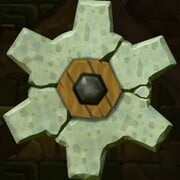 |
Cog | Gear-like platforms that the player must go under to pass. If they remain under one, they will be squished and lose a life. | Crushing-Cogs Tower | Crushing-Cogs Tower |
 |
Current | Underwater currents that push the player. | Blooper's Secret Lair | Swim for Your Life! |
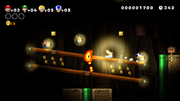 |
Dark | Obstacles that blocks the player's view. Glowing Baby Yoshi, fire and Invincible Mario can light up dark areas. | Perilous Pokey Cave | Thrilling Spine Coaster |
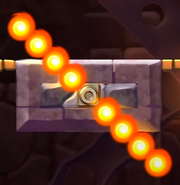 |
Fire Bar | A series of fireballs that rotate infinitely, either clockwise or counterclockwise. | Screwtop Tower | Slide Lift Tower |
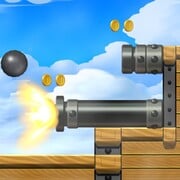 |
Giant cannon | Horizontal, pipe-sized cannons shoot giant cannonballs. | The Mighty Cannonship | The Mighty Cannonship |
 |
Giant cannonball | Large variants of cannonballs launched by giant cannons. | The Mighty Cannonship | The Mighty Cannonship |
 |
Hammer Pendulum* | Mallet-like platforms that swing back and forth on a 180-degree arc. | Hammerswing Caverns | Hammerswing Caverns |
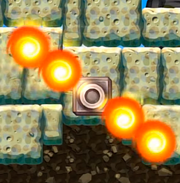 |
Huge Fire Bar | A larger version of a Fire Bar. | Slide Lift Tower | Fire Bar Cliffs |
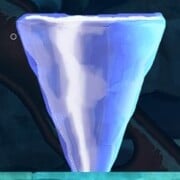 |
Huge Icicle* | Large icicles that fall and act as platforms. | Freezing-Rain Tower | Icicle Caverns |
 |
Icicle | Icicles that fall when the player gets close underneath. | Freezing-Rain Tower | Wendy's Shifting Castle |
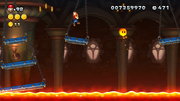 |
Lava | Pits of lava cause the player to instantly lose a life upon contact. | Lemmy's Swingback Castle | The Final Battle |
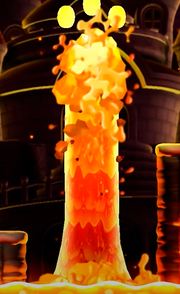 |
Lava Geyser | Pillar of lava that rises up from pits. | Meteor Moat | Meteor Moat |
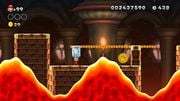 |
Lava swell | Lava that moves up in waves. | Iggy's Volcanic Castle | Iggy's Volcanic Castle |
 |
Mecha Hand | A large mechanical hand modeled after Bowser's own hand that attempts to crush the players while they are on board. | The Mighty Cannonship | Boarding the Airship |
 |
Meteor | Rocks that fall slowly and break upon hitting either the ground or a block. | Meteor Moat | Firefall Cliffs |
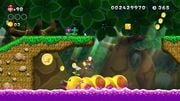 |
Poison | A liquid hazard that causes the player to instantly lose a life. | Bridge over Poisoned Waters | Spinning Platforms of Doom |
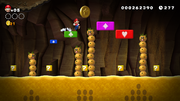 |
Quicksand | Sand that sinks the player. | Stone-Eye Zone | Blooming Lakitus |
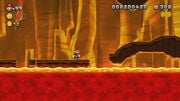 |
Rising lava | Lava that rises up. | Rising Tides of Lava | Rising Tides of Lava |
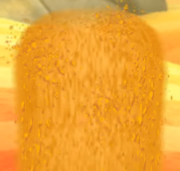 |
Sand Geyser | Pillars of sand that rises up from pits at regular intervals, and can be used as platforms. | Stone-Eye Zone | Spike's Spouting Sands |
 |
Spinner | A large, undefeatable spiked ball on a chain. | Snake Block Tower (regular) Pendulum Castle (large) |
Pendulum Castle (regular/large) |
 |
Skewer | Spiked columns that extend out of walls and retract at regular intervals. Both vertical and horizontal Skewers appear. | Giant Skewer Tower | Giant Skewer Tower |
 |
Torpedo tube | An indestructable box that fires Torpedo Teds. | Larry's Torpedo Castle | The Mighty Cannonship |
 |
Torpedo Base | Red torpedo tubes that fire Targeting Teds instead of Torpedo Teds. | The Mighty Cannonship | The Mighty Cannonship |
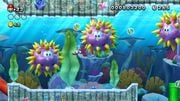 |
Water | Large bodies of harmless liquid that the player(s) can swim through. | Blooper's Secret Lair | Swim for Your Life! |
| File:NSMBU Water Geyser.png | Water Geyser | Pillars of water that rise from below and serve as platforms, similar to Sand Geysers. | Waterspout Beach | Larry's Torpedo Castle |
Bosses
Tower bosses
| Image | Name | Description
|
|---|---|---|
 |
Boom Boom | The tower boss from Crushing-Cogs Tower in Acorn Plains to Grinding-Stone Tower in Rock-Candy Mines. He does not change in the first battle, especially on Crushing-Cogs Tower in Acorn Plains. However, following his first defeat, Magikoopa gives him special abilities. In Stoneslide Tower from Layer-Cake Desert, Magikoopa will grant him the ability to spin jump. In Giant Skewer Tower from Sparkling Waters and Freezing-Rain Tower from Frosted Glacier, Magikoopa will grant him the ability to jump, similar to Super Mario Bros. 3. In Snake Block Tower from Soda Jungle, Magikoopa will make him larger. In Grinding-Stone Tower from Rock-Candy Mines, Magikoopa will transform his arms into wings, similar to Super Mario Bros. 3. |
 |
Boss Sumo Bro | Boss Sumo Bro was a regular Sumo Bro until Magikoopa made him grow in size. He is normally immune to attacks from the top due to the spike on his head, but he will jump between platforms which the player can hit from the bottom. Knocking him off a platform makes him vulnerable to jump attacks. He is fought on Screwtop Tower. |
 |
Magikoopa | Magikoopa is fought on Slide Lift Tower and teleports most of the time when Mario gets too close. However, when he stops to attack Mario, he is left vulnerable to Mario's jumping. He also casts spells on Boom Boom, Boss Sumo Bro, and Bowser granting them extra power before their battles, such as causing them to grow in size. |
Castle/airship bosses
| Image | Name | Description
|
|---|---|---|
 |
Lemmy Koopa | Lemmy Koopa is fought on Lemmy's Swingback Castle in Acorn Plains and attempts to throw bombs at Mario. |
 |
Morton Koopa Jr. | Morton Koopa Jr. is fought on Morton's Compactor Castle in Layer-Cake Desert and uses a large hammer that is apparently filled with magic to knock Big Pokey segments in the player's way after shaking the ground by stomping on it. He can knock Pokey segments straight at the player or knock them in high arcs. |
 |
Larry Koopa | Larry Koopa is fought on Larry's Torpedo Castle in Sparkling Waters and blasts fireballs and use water blasts from the pool below the arena. When Larry is spinning in his shell, the water geysers give his shell a boost upwards, making it a bit tricky to avoid. After two stomps, Larry begins to cast two fireballs in quick succession. |
 |
Wendy O. Koopa | Wendy O. Koopa is fought on Wendy's Shifting Castle in Frosted Glacier and skates around the arena, shooting out two energy rings that ricochet off of walls and can knock down the icicles at the ceiling of the airship. She also spin jumps from walls. After she is jumped on twice, she will shoot out three rings instead. |
 |
Iggy Koopa | Iggy Koopa is fought on Iggy's Volcanic Castle in Soda Jungle and uses the four warp pipes to run around the room and on the ceiling to make it trickier for the player to stomp on him as he uses his Magic Wand to shoot three fireballs, with some being his usual green flame, and the other being red skeleton orbs that generate Magmaarghs when they land into the lava below. When Iggy is stomped on, he will dash around the room in his shell using the pipes on the walls, which will switch him to the other side of the room. Unlike the other Koopalings where they spin in their shells and change directions at the edges or walls of the room, Iggy can actually change directions anywhere around the room during his duration in his shell. |
 |
Roy Koopa | Roy Koopa is fought on Roy's Conveyor Castle in Rock-Candy Mines and shoots Bullet Bills with his cannon and jump between platforms that move around during the fight. Occasionally, he shoots Missile Bills. He can also jump high in the air and ground pound the floor or platform, which makes him fire Bullet Bills on both sides of his blaster. The ground pound can also make the floating platforms appear after he comes out of his shell. |
 |
Ludwig von Koopa | Ludwig von Koopa is fought on Ludwig's Clockwork Castle in Meringue Clouds and levitates in the air while making two clones of himself, and all three Ludwigs will blast fireballs at Mario before dropping onto the ground. If one of the clones is jumped on, it will simply disappear. There are four ways to find out which is the real one. The one that is the real one fires three fireballs, while the clones fire two. The clones keep their eyes half-open, and tend to assume the real Ludwig's pre-battle idle pose while not levitating. The real Ludwig will also drop to the ground last, after the clones, as well as laugh while dropping. Finally, Mario always looks at the real Ludwig if he can see him directly, just as he does with the other bosses. When the fight starts off, after shooting their fireballs, the clones disappear before landing. After the first stomp, the clones do not disappear. After the second stomp, not only do all three Ludwigs shoot faster, but swap positions, though the real Ludwig still shoots three fireballs. |
 |
Bowser Jr. | Bowser Jr. is fought on airships. In Soda Jungle's The Mighty Cannonship, Bowser Jr. uses his Junior Clown Car as a submarine underwater, in which the player must guide the Targeting Teds that Bowser Jr. shoots into his submarine. With every hit, he summons three Torpedo Teds from the left and right or from the ceiling and the floor. In Meringue Clouds' Boarding the Airship, Bowser Jr.'s boss battle involves him in his Clown Car equipped with boxing gloves, which he uses to destroy the blocks the player is standing on. Bowser Jr. periodically throws Bob-ombs, which the player can use against him. However, in Peach's Castle's The Final Battle, he cannot be defeated. |
 |
Bowser | Bowser is fought in The Final Battle in Peach's Castle. The first part of his battle is similar to Super Mario Bros., where the player has to get to the other side and press the switch; alternatively, shooting several fireballs also works. This causes the axe to fall and make the bridge collapse, making Bowser fall. The gate then opens and Mario moves on. When Mario reaches the top of the castle, Peach is being held up in the tower. After this, Bowser Jr. shows up in his Junior Clown Car, and Bowser hops on top of the castle while he is huge. Bowser Jr. also fights the player. In order to defeat them, the player must jump on Bowser Jr., causing him to fall out of his Junior Clown Car. This allows the player to jump in and hover over Bowser to harm him. Like the Koopalings, he curls into his shell and spins around when hit. He is defeated after being hit three times by the Clown Car. |
Items and objects
Items
| Image | Name | Function
|
|---|---|---|
 |
1-Up Mushroom | Gives the player an extra life. |
 |
3-Up Moon | Gives the player three extra lives. Only appears in Boost Mode. |
 |
Coin | Collecting 100 of these gives the player an extra life. |
 |
Blue Coin | These coins are just like normal coins, but they appear by hitting a P Switch. |
 |
Red Coin | Collecting all eight Red Coins that appear after passing through a Red Ring gives a Super Mushroom, Fire Flower, or 1-Up Mushroom, depending on what power-up the player is currently using. |
| Green Coin (new) | Collecting all five groups of Green Coins that appear after passing through a Green Ring gives a Super Mushroom, Fire Flower, or 1-Up Mushroom, depending on what power-up the player is currently using. | |
 |
Hidden Coin | An outline of a coin that becomes a coin if Mario goes through it. These coins are very common in Coin Battle. |
| Star Coin | Three of these are located in every course in hard-to-reach or hidden areas. | |
 |
Red Ring | Makes eight Red Coins appear. If the player collects all eight coins before they disappear, they receive either a power-up, which varies in between levels, or a 1-Up Mushroom, depending on the player's current size. |
 |
Green Ring | Makes fifteen Green Coins appear. If the player collects all five groups of green coins before they disappear, they receive either a power-up, which varies in between levels, or a 1-Up Mushroom, depending on the player's current size. |
| Yoshi egg | An egg that Yoshi comes out of or produces after eating five fruits, which contain power-ups. They come in two different colors: green releases a normal green Yoshi; while yellow releases a Glowing Baby Yoshi. As Bubble Baby Yoshi and Balloon Baby Yoshis are found on the world map, they do not come out of eggs. | |
| Fruit | A fruit that Yoshi eats. When Yoshi eats five fruits, he makes an egg that contains an item. | |
 |
Barrel | An item that the player can pick up and throw at enemies to defeat them and at coins to collect them. Broozers can also throw them. Another player who touches a barrel while it rolls will take damage. |
 |
Crate | A wooden box Mario can break via a Ground Pound. Sometimes contains coins or power-ups. |
| Iron Block | An iron box that drops on Conveyor Belts. They are indestructible and causes the player to lose a life if crushed. | |
| Frozen Coin | A coin encased in solid ice that can be melted by fire to be collected. | |
 |
Flower | A common background object that releases a coin when spun next to. |
| File:NSMBW P-Switch Sprite.png | P Switch | Not only turns bricks into coins or vice versa, but also reveals Blue Coins. |
 |
? Switch | Changes or adds things to an area, such as platforms, for a limited time. |
 |
! Switch | Activating the switch enables the axe to destroy the bridge, causing Bowser to fall. |
 |
Trampoline | A spring that lets the player jump high into the air. It can be picked up and carried around. |
 |
Checkpoint Flag | A flag that acts like a checkpoint. It has Bowser's insignia, but if a player touches it, it is replaced by whichever character's symbol turned it. If that character is in their Small form, they transform into their Super form. |
 |
Goal Pole | Flagpoles found at the end of every level. Touching one completes the level. |
 |
Goal Pole (secret) | Flagpoles with red flags, found at the end of some levels. Touching one completes the level and leads to secret exits. |
Power-ups
| Image | Name | Function
|
|---|---|---|
 |
Super Mushroom | Turns Mario into Super Mario. |
 |
Fire Flower | Turns Mario into Fire Mario. |
 |
Super Acorn (new) | Turns Mario into Flying Squirrel Mario. |
 |
Mini Mushroom | Turns Mario into Mini Mario. |
 |
Ice Flower | Turns Mario into Ice Mario. Mario can shoot ice balls to freeze most enemies. |
| Propeller Mushroom | Turns Mario into Propeller Mario and gives him some short flight. | |
 |
Penguin Suit | Turns Mario into Penguin Mario. Mario can shoot ice balls and slide on his belly, along with having an improved swimming ability. |
 |
P-Acorn (new) | Turns Mario into P Flying Squirrel Mario. |
| Super Star | Turns Mario into Invincible Mario. | |
 |
Boost Star (new) | A star that appears during Boost Mode. |
Objects
Blocks
| Image | Name | Function
|
|---|---|---|
    |
? Block | Contains a coin or item when hit. |
    |
Brick | Breaks or contains coins when hit. |
 |
Coin Block | A block that contains many coins. Looks just like a brick and becomes an Empty Block when used. Pops out five coins when used quickly |
| Flying ? Block | A type of ? Block that flies in a rhythmic pattern to the music of a stage. Once hit, it becomes an Empty Block. | |
    |
Empty Block | A block that cannot be broken. When a ? Block is hit, it turns into an Empty Block. |
    |
Mega ? Block | A large ? Block that acts like a normal block. |
    |
Big Block | A large Brick Block that acts like a normal block. |
    |
Big Empty Block | A giant block that cannot be broken. When a Mega ? Block is hit, it turns into an Big Empty Block. |
 |
Jump Block | A block that makes Mario jump higher when he jumps or steps on it. |
 |
POW Block | A block that causes a large tremor on the ground when thrown. |
| Roulette Block | A block with various items scrolling on it. Mario can hit it and release the power-up shown. | |
 |
3-Up Moon Block (new) | An very rare block that contains a 3-Up Moon. |
| Super Guide Block | Appears after Mario loses five lives in a row in one stage. When this block is hit, Luigi clears the stage for Mario. | |
| Boost Block (new) | Blocks that appear when touching the screen on the Wii U GamePad. | |
 |
Light Block (new) | A block that shines light in dark areas. |
 |
Ice Block | A block that is created by an enemy that was frozen with an ice ball. This block can be picked up and thrown like a barrel. |
| Ice Chunk (new) | A giant variant of an Ice Block that serves as a platform. It functions similarly to Iron Blocks, which can also crush the player. | |
 |
Stretch Block | A block made up of five segments that stretches to act as a bridge in certain levels. |
| Donut Block | A platform that falls under weight if Mario stays there for too long. As Mini Mario, he is too light to make it fall; as such, it becomes safer. | |
| Snake Block | Green blocks that move like a snake once Mario steps on it. | |
| Giant Snake Block (new) | Giant variants of a Snake Block. | |
 |
Hard Block | Block that can only be destroyed by Bob-omb explosions or some large/spiky enemies like Grrrols or Big Thwomps. |
Transportation objects
| Image | Name | Function
|
|---|---|---|
    |
Warp Pipe | Pipes going through the ground that transport the player to new areas. In World |
    |
Small pipe | Mini variants of warp pipes that can be acessed with a Mini Mushroom. |
 |
Pipe Cannon | Pipes that launch players to another location or a platform that they are unable to reach. |
 |
Warp Door | A door found in Ghost Houses, fortresses, and castles that take the player to another portion of the level. Large doors serve as entry points to a boss. |
Climbable objects
| Image | Name | Function
|
|---|---|---|
| Beanstalk | Used as a ladder that can lead to Coin Heaven, or a secret place. Grows out of an Invisible Block or Brick Block. | |
| File:NsmbuLadder.png | Ladder | A climbable object used to get on top of platforms. |
| File:NsmbuPole.png | Pole | Striped poles that the player can climb up and slide down after jumping onto them. |
 |
Chain-Link | Fences that the player can climb. |
Platforms
| Image | Name | Function
|
|---|---|---|
| Bridge | A semisolid platform that connects between ground platforms. | |
| Cloud Lift | Long platforms that move to the right when initially landed on. | |
 |
Scale Lift | Scale-like platforms that causes the one platform to rise if the player lands on the parallel one. It will fall off if they stand on it for too long. |
| Arrow Lift (new) | Lifts that appear turn from blue to red when activated, causing them will move in the opposite direction from where they are pointing while idle. | |
| File:NsmbuBoltLift.png | Bolt Lift | A set of nuts that are screwed onto a very long bolt that serve as platforms. The player must continually jump to avoid falling. |
| Screwtop Lift | A lift with a screw that the player can move in a set direction by spinning. | |
| Limited Lift | A lift that the player can travel with a limited capacity of at least five enemies. It stops once the counter reaches 0. | |
 |
Cross Lift (new) | A lift that not only expands and contracts horizontally, but also conversely expands and contracts vertically. |
 |
Slide Lift (new) | Lifts that are aligned either horizontally or vertically and move in a rectangular fashion either clockwise or counterclockwise. |
 |
Star Lift (new) | Star-shaped platforms that spin depending on which side of them is weighed down by the player. |
 |
Mushroom Platform | Mushrooms that serve as platforms. |
 |
Stretch Shroom | Mushroom Platforms that contract and extend at constant intervals, pulling anything and anyone on the ends of the platforms to the center when they contract. |
| File:NSMBW SpinKinokoLift.png | Screwtop Shroom | A rare Mushroom Platform that only appears in Rising Tides of Lava. When spun on, it lowers another lift's height. |
 |
Seesaw Shroom (new) | A mushroom platform that acts as a seesaw. |
| Bouncy Cloud | Cloud platforms that makes the player and enemies bounces very high. | |
| Remote-Control Platform | A lift that the player can tilt and move on tracks by tilting the Wii U GamePad or the Wii Remote or by alternating between pressing | |
| Paddle Platform | A paddle wheel-like platforms made of 4 smaller platforms that moves in a wheel on tracks. | |
| File:NsmbuPendulumPlatform.png | Pendulum Platform | Chained platforms that sway from side to side indefinitely. |
 |
Screwtop Platform | A platform with a screw that the player can move in a set direction by spinning. |
| Spine Coaster | Rideable creatures made of bone used to aid Mario and company to pass through pits and pits. | |
 |
Water Ball | A huge mass of water that floats in the air. Acts as if Mario and co. are in water. |
 |
Semisolid Platform | Platforms the player can jump on from the bottom. |
 |
Leaf Platform (new) | Leaves that serve as platforms appearing on giant beanstalks. When they first sprout, they appear to be green, only to turn red and brown then slowly float down after some time has passed. |
 |
Bean Platform (new) | Large beans serving as platforms that periodically coil and uncoil. |
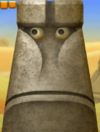 |
Stone-Eye (new) | Giant gray stone heads that either move in different patterns, or stay completely stationary. Stone-Eyes are sentient, indicated by their eyes that constantly stare at the player. |
| File:NsmbuConveyorBelt.png | Conveyor Belt | Moving platforms that carry the player and, sometimes, Iron Blocks and enemies. |
 |
Turning Floor | Continually moving objects that turn clockwise or counterclockwise, moving anything on them. |
 |
Rolling log | Cylindrical wooden platforms that, when stood on, roll over. The player must run along them or jump carefully to avoid falling off until they reach their destination on a set path. |
 |
Seesaw Log Bridge (new) | Solid wooden platforms that teeter to one side when a player or element stands on the opposite side. |
| Floor | Platforms that the player can bump from below to stun enemies. | |
 |
Gear platform | A platform with gears that moves left and right. |
| File:NsmbuWobbleRock.png | Wobble Rock | Rock platforms that wobble from left to right when the player stands near one of its edges. |
 |
Bridge (new) | A floor made up of skeleton bones. When Bowser Jr. slams down on a bridge with his Junior Clown Car, it causes brief ripples that can stun the player and enemies. |
Reception
New Super Mario Bros. U has received generally positive reviews. The game currently maintains an 84 average on Metacritic[2] and had an 84.48% on GameRankings.[3] GameXplain gave the single-player and multi-player modes 4 stars out of 5,[4] IGN gave it a score of 9.1 out of 10,[5] EGM[6] gave a score of 9/10, Joystiq gave it 4.5 stars out of 5,[7] Polygon[8] and Destructoid[9] gave the same score of 8.5/10, VentureBeat[10] gave it a score of 83/100 (83%), Games Radar gave it 4 stars out of 5,[11] and Gamespot gave a score of 8.5.[12]
The game has been praised for its balanced gameplay and challenge mode, with IGN's Rich George describing it as "the best thing to come to Mario's world since 3D", while criticizing it as not pushing the Wii U's visuals and audio potential. He also stated, "though it doesn't necessarily redefine Nintendo's iconic hero, it still manages to capture the sense of carefree adventure that many of us felt as kids." He also criticized the game's "weak graphics and audio, plus the return of the irritating chaotic, bouncy multiplayer mode." He praised the progressing difficulty in the game and the additional difficulty of Challenge Mode.
| Reviews | |||
|---|---|---|---|
| Reviewer, Publication | Score | Comment | |
| Jim Sterling, Destructoid | 8.5/10 | "New Super Mario Bros. U is a great little platformer that kicks off the Wii U launch with a bang. Players know exactly what they're getting with this one -- an entertaining and incomplex bit of gaming that provides challenge and smirks in equal measure. While certainly a "safe" game to launch with, it is by no means unremarkable, and the only people who would fail to have fun are those with a fundamental aversion to Mario or platformers in general. Literally everybody else would find it incredibly difficult to dislike this one ... even if some of those latter stages will make them temporarily despise it. Because nobody likes lava levels. Nobody." | |
| Christian Donlan, Eurogamer | 9/10 | "Is the plumber's Wii U debut as good as his recent 3D outings? Not quite, but for the New Super Mario Bros. series, it's a real step forward in detailing, imagination and character. There's always been a keen Mario brain working away inside these 2D design exercises. Now, it feels like there's a proper soul to go along with it." | |
| Richard George, IGN | 9.1/10 | "It's difficult to find freshness or brilliance in a 2D landscape. Mario's world is now three decades old. That would seem to suggest new territory is scarce, and in some ways the formulaic New Mario series had come to reinforce that fear. But New Super Mario Bros. U demonstrates there's not just life left in this type of game, but that it can be modern and nostalgic at the same time. Nintendo's approach here strikes a great balance in all areas, ranging from its difficulty to design to enemies and bosses. And for everything the basic Story Mode does right – and that's a considerable amount – the Challenge Mode will be remembered as a key moment in the life of the New Mario series, where Nintendo realized it didn’t have to sacrifice the core gamer’s experience at the expense of a more casual audience. This is how Mario can and will appeal to everyone." | |
| Aggregators | |||
| Compiler | Platform / Score | ||
| Metacritic | 84 | ||
| GameRankings | 84.48% | ||
Sales
As of March 31, 2014, New Super Mario Bros. U is the 3rd best-selling game for the Wii U, having sold about 4.16 million copies worldwide. As of September 30, 2021, it had sold 5.82 million copies worldwide.[13]
Updates
Release date: November 18, 2012
Released at launch, the first update adds the game's Miiverse functionality.
Release date: March 15, 2013[14]
The second update causes any Miiverse posts made in-game to be posted to a separate "Game Posts" community rather than the standard community.
Release date: June 20, 2013[15]
The third game update adds the ability for the game to receive the New Super Luigi U downloadable content and puts a prompt in-game to go to the Nintendo eShop to download it. The update also adds support for the Wii U Pro Controller.
New Super Luigi U
- Main article: New Super Luigi U
In July 2013, as part of the Year of Luigi celebration, a large-scale expansion pack titled New Super Luigi U was released as downloadable content for New Super Mario Bros. U on the Nintendo eShop, and was later released as a standalone title at retail. The pack contains 82 new courses in place of the original ones, featuring Luigi as the main character in the place of Mario, who does not appear at all within the game.
The game features the same multiplayer, with the option of playing as Yellow Toad, Blue Toad, or Nabbit (who cannot power-up like the other characters, but is impervious to enemy damage). The game features similar physics to that of Luigi's style of gameplay in Super Mario Bros.: The Lost Levels, in that the characters run faster and jump higher, but stop slower. The levels have also been designed to be more challenging, with each one being shorter and featuring a 100 second time limit.
The Mario & Luigi Deluxe Set Wii U bundle released in November 2013 includes with it both games put onto one disc, titled New Super Mario Bros. U + New Super Luigi U. In addition to being a compilation of both games, this release includes several bonus videos.
With the discontinuation of digital purchases for Wii U in March 2023, it is no longer possible to buy New Super Luigi U as DLC for New Super Mario Bros. U, though it can still be downloaded by those who purchased it when it was available.
Development
As stated above, New Super Mario Bros. U was based upon the New Super Mario Bros. Mii Wii U experience demo shown off at E3 2011.[16] A translation of a Spanish online magazine revealed that the new title was in development and would be revealed at E3 2012,[17] with the game fully revealed to be New Super Mario Bros. U during the E3 trailer.[18]
New Super Mario Bros. U began development soon after the completion of New Super Mario Bros. Wii, using pre-existing elements from the Wii game, as development equipment for the Wii U did not exist at the time.[19] The game's singular, interconnected world map was inspired by the one seen in Super Mario World; Masataka Takemoto desired to take the map from that game and use the Wii U in order to recreate and expand upon the concept.[20] The map being seamless also had a role in Miiverse integration, as with the setup of the map it was possible to display comments across each of the levels.[21] The concept of drop-in play with one player on the Gamepad placing blocks was brought up early in development. When the Wii U Gamepad was brought up during development, the team began to conceptualize ways to use it, talking specifically about the drop-in play. Wanting to make a feature with "controls that you can understand right away with no explanation," the concept of using the GamePad to place blocks the other players can jump on went through.[19]
Challenge Mode was based upon the idea of setting a self-challenge in the previous games, as well as the challenge site for New Super Mario Bros. Wii. Because of ideas like this, the developers decided to put the Challenge Mode into the game from the beginning. The challenges were created with all types of skill levels in mind.[22]
Boost Rush Mode was based on the Free-for-All Mode featured in New Super Mario Bros. Wii, in that they wanted a similar mode for playing the main game stages in short bursts. The developers tried connecting courses together and playing them through, but found it uneventful; they then added the concept of collecting coins resulting in the screen scrolling faster, and found it to fit a Super Mario-style of gameplay.[20]
Pre-release and unused content
Miis were originally going to be playable in the game's Story Mode. In the final game, Mii playability is restricted to the bonus modes. Additionally, Boost Mode was also originally titled "Assist Play". The Acorn Plains map as seen in the E3 showcase for the game is also very different from the version seen in final game.
Gallery
- For this subject's image gallery, see Gallery:New Super Mario Bros. U.
Mario, Luigi, Blue Toad, and Yellow Toad
Mario and Yoshi
A Waddlewing holding a Super Acorn
Media
- For a complete list of media for this subject, see List of New Super Mario Bros. U media.
| File info 0:30 |
| File info 0:30 |
| File info 0:30 |
| File info 0:30 |
Glitches
By entering a Warp Pipe or door in any stage exactly when the timer hits zero, the player does not die, and they can explore the level indefinitely.
Staff
- Main article: List of New Super Mario Bros. U staff
New Super Mario Bros. U was produced by Takashi Tezuka and Hiroyuki Kimura, with Masataka Takemoto as the director and Tsutomu Kaneshige and Shinichi Ikeamtsu as the general coordinators. Satoru Iwata was the executive producer, with the general producer being Shigeru Miyamoto. Masanobu Sato was the lead designer, and Shiro Mouri was the programming director. The music was composed by Shiho Fujii and Mahito Yokota, with Koji Kondo as sound adviser.
References to other games
- Mario Bros.: Coin Courses-2 is based on the levels in this game with similar platforms and Koopa Troopas acting like as Shellcreepers.
- Super Mario Bros.: The second level is an underground level with a secret path over the ceiling passing over the exit Warp Pipe, leading to a secret exit. In the final battle with Bowser, when Mario hits the switch, it causes an axe to fall and break the bridge. Sprites from this game are used in the game menus.
- Super Mario Bros. 3: Boom Boom is fought as the mid-boss of each world. The Super Acorn is comparable to the Super Leaf, as it has a P-variation. The Koopalings, which originated from this game, have airships once again. Airship levels, and the castle rooms before entering a Koopaling's airship, both use a remastered version of the airship theme from Super Mario Bros. 3.
- Super Mario World: The world map is connected again and a ghost ship, similar to the Sunken Ghost Ship level, appears in this game. The Warp Pipes have a similar structure to the ones in Super Mario World. Most of the worlds are named after food again. Some of the world's features are similar to those found in Dinosaur Land (e.g. Acorn Plains having jagged mountains or Soda Jungle being one-third based on the Forest of Illusion). Super Mario World has the exact same number of exits that this game has: 96.
- Super Mario World 2: Yoshi's Island: The name of the Challenge "Spin Jump, Get Dizzy" is a reference to that of a level from this game, Touch Fuzzy, Get Dizzy. Bubble Baby Yoshi's abilities maybe a reference to how Yoshi can shoot bubbles in this game including how the player can bounce off the bubbles. Kamek uses his magic to enhance Boom Boom's attacks, just as he did with this game's bosses. He also grows Bowser to a large size, similar to the final fight with Baby Bowser.
- New Super Mario Bros.: Cloud Lifts are redesigned to better resemble their New Super Mario Bros. counterparts and compress when stood on, just like in this game.
- Mario Kart Wii: The Red Shell and Green Shell use their artworks from this game, but the Green Shell's artwork is mirrored.
- New Super Mario Bros. Wii: The title is the sequel to this game. Many graphical, audial, and technical assets were reused from this game. Kamek growing Bowser with magic could also be a reference to this game's final fight, where similar events transpired. The main gimmicks in Princess Peach’s Kingdom's tower and castle levels, Pendulum Platforms and cogs respectively, are switched in order of appearance between Acorn Plains' Crushing-Cogs Tower and Lemmy's Swingback Castle.
- Super Mario Galaxy 2: Balloon Baby Yoshi and Glowing Baby Yoshi's abilities are similar to those of Blimp Yoshi and Bulb Yoshi, respectively. Magmaarghs and Magmaws return from this game.
- Super Mario 3D Land: Boom Boom's voices are reused, as well as the motion patterns of some of the enemies.
- Mario Kart 7: The Miis reuse their voice clips from this game.
- New Super Mario Bros. 2: The title is a follow-up to this installment. The Note Block sounds are reused. The Goal Pole also produces the flag containing the emblem of the topmost character, also seen in this game.
- Paper Mario: Sticker Star: The Ghost House doors use the design from The Enigmansion in this game rather than the one from New Super Mario Bros. Wii. The Bony Beetle's design is reused. Also, Bowser Jr. uses the same glass dome in his clown copter as in this game.
References in later games
- Mario Kart 8: Mecha Cheeps reappear in the underwater sections of Water Park.
- Mario Golf: World Tour: Layer-Cake Desert, Sparkling Waters, and Rock-Candy Mines appear as downloadable courses in this game. Some pieces of Mii gear are based upon both Nabbit and the Boss Sumo Bro, both of which originate from this game. Nabbit returns as a downloadable playable character.
- Super Smash Bros. for Wii U: A stage based on New Super Mario Bros. U, Mushroom Kingdom U, appears in this game.
- Mario Party 10: A few of the minigames take place in areas that resemble some of the worlds in New Super Mario Bros. U, such as Cheep Cheep Leap taking place in Sparkling Waters and Fruit Scoot Scurry taking place in Layer-Cake Desert.
- Super Mario Maker/Super Mario Maker for Nintendo 3DS: The fourth game style in these games is based on New Super Mario Bros. U.
- Super Mario Run: The graphics, as well as most of the music, are based on New Super Mario Bros. U.
- Mario Party: Star Rush: The underwater theme from New Super Mario Bros. Wii appears as a song from New Super Mario Bros. U in the Rhythm Recital mode for this game.
- Super Smash Bros. Ultimate: The stage Mushroom Kingdom U from Super Smash Bros. for Wii U returns as a stage in this game. The Koopalings, Nabbit, Boo, Hammer Bro, Banzai Bill, Thwomp, Bob-omb, Flying Squirrel Toad, Super Mushroom, Fire Flower, and Super Star appear as spirits, using their artwork from New Super Mario Bros. U.
- Super Mario Maker 2: Like the previous Super Mario Maker games, the fourth style in this game is based on New Super Mario Bros. U.
- WarioWare: Get It Together!: This game features a microgame based on New Super Mario Bros. U.
Names in other languages
| Language | Name | Meaning | Notes |
|---|---|---|---|
| Japanese | New スーパーマリオブラザーズ U[?] Nyū Sūpā Mario Burazāzu Yū |
New Super Mario Bros. U | |
| Chinese (simplified) | New 超级马力欧兄弟 U[23] New Chāojí Mǎlì'ōu Xiōngdì U |
New Super Mario Bros. U | |
| Chinese (traditional) | New 超級瑪利歐兄弟U[23] New Chāojí Mǎlì'ōu Xiōngdì U |
New Super Mario Bros. U | |
| Korean | 뉴 슈퍼 마리오브라더스 U[?] Nyu Syupeo Mariobeuradeoseu Yu |
New Super Mario Bros. U; as named in New Super Mario Bros. U Deluxe |
Trivia
- If the Miis are selected as P1, they will be colored like Mario. If P2, they will be colored like Luigi. If P3, they will be colored like Wario. If P4, they will wear blue shirts and dark blue overalls, similar to Luigi's light blue alternate costume from the Super Smash Bros. series. This could be a reference to the player 4 in some of the Wii U Virtual Console ports of the Game Boy Advance iteration of Mario Bros.
- When the Mario Bros., Toads, or Miis are not moving, they stop and stare at the screen until the player starts moving them again.
- Sometimes, on the title screen, Luigi almost trips over instead of jumping and ground-pounding the ground.
- In this game, New Super Luigi U, and their Nintendo Switch port, Yellow Toad and Blue Toad's in-game voices are swapped compared to New Super Mario Bros. Wii. However, their voices in the menus and character selection screen are still the same as the previous game. In Super Mario Maker 2's New Super Mario Bros. U-style, Toad's voices are a combination of both of them.
- Bowser transforming Peach's castle into a stronghold of his in this game is similar to the climax of Super Mario Bros.: Peach-hime Kyūshutsu Dai Sakusen!
External links
References
- ^ Kazuya Sakai (Ambit), kikai, Akinori Sao, Junko Fukuda, Kunio Takayama, and Ko Nakahara (Shogakukan) (ed.) (2018). Encyclopedia Super Mario Bros.. Milwaulkie: Dark Horse Books. ISBN 978-4-09-106569-8.
- ^ New Super Mario Bros. U. Metacritic (English). Retrieved May 13, 2024.
- ^ New Super Mario Bros. U for Wii U. GameRankings (English). Archived December 9, 2019, 01:33:58 UTC from the original via Wayback Machine. Retrieved May 13, 2024.
- ^ GameXplain (November 15, 2012). New Super Mario Bros. U - Video Review (Wii U) [HD]. YouTube (English). Retrieved May 13, 2024.
- ^ George, Richard (November 15, 2012). New Super Mario Bros. U Review. IGN (English). Retrieved May 13, 2024.
- ^ Carsillo, Ray (November 15, 2012). EGM Review: New Super Mario Bros. U. EGMNOW (English). Archived November 16, 2012, 10:07:44 UTC from the original via Wayback Machine. Retrieved May 13, 2024.
- ^ Mitchell, Richard (November 15, 2012). New Super Mario Bros. U review: A return to form. Joystiq (English). Archived November 18, 2012, 05:30:42 UTC from the original via Wayback Machine. Retrieved May 13, 2024.
- ^ Kollar, Phillip (November 15, 2012). New Super Mario Bros. U review: new tricks. Polygon (English). Retrieved May 13, 2024.
- ^ Sterling, Jim (November 15, 2012). Review: New Super Mario Bros. U. Destructoid (English). Archived November 17, 2012, 14:44:25 UTC from the original via Wayback Machine. Retrieved May 13, 2024.
- ^ McLaughlin, Rus (November 15, 2012). New Super Mario Bros. U is far from new (review). VentureBeat (English). Retrieved May 13, 2024.
- ^ Gilbert, Henry (November 15, 2012). New Super Mario Bros U review. Gamesradar (English). Retrieved May 13, 2024.
- ^ GameSpot (November 17, 2012). GameSpot Reviews - New Super Mario Bros. U. YouTube (English). Retrieved May 13, 2024.
- ^ Nintendo (May 10, 2022). Top Selling Title Sales Unites. Nintendo (Japanese). Retrieved May 13, 2024. (Archived August 2, 2017, 04:49:50 UTC via Wayback Machine.)
- ^ Bonds, Curtis (March 15, 2013). v.1.2.0 Released for New Super Mario Bros. U. Nintendo World Report (English). Retrieved November 28, 2014.
- ^ Colette (June 20, 2013). New Super Mario Bros. U Update Allows Wii U Pro Controller Use]. My Nintendo News. Retrieved May 13, 2024.
- ^ Newton, James (April 17, 2012). Mario Wii U "Based On" New Super Mario Bros. Mii. Nintendo Life. Retrieved May 13, 2024.
- ^ Newton, James (April 16, 2012). Miyamoto To Show Wii U Mario at E3. Nintendo Life. Retrieved May 13, 2024.
- ^ Nintendo of America (June 5, 2012). Wii U - New Super Mario Bros. U E3 Trailer. YouTube. Retrieved May 13, 2024.
- ^ a b Iwata Asks : New Super Mario Bros. U : "What Should Be New?". Nintendo. Retrieved May 13, 2024.
- ^ a b Iwata Asks : New Super Mario Bros. U : One Map. Nintendo. Retrieved May 13, 2024.
- ^ Iwata Asks : New Super Mario Bros. U : Reading the Posts in your Hands. Nintendo. Retrieved May 13, 2024.
- ^ Iwata Asks : New Super Mario Bros. U : "Mottainai (What a Waste)!". Nintendo. Retrieved May 13, 2024.
- ^ a b Super Mario Maker 2 in-game name
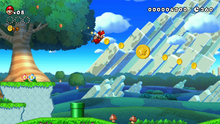
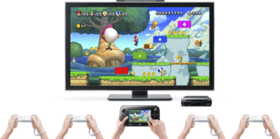
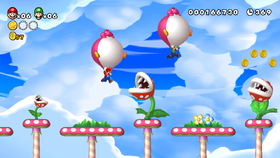
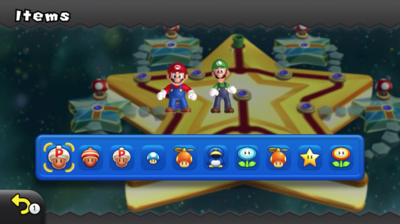
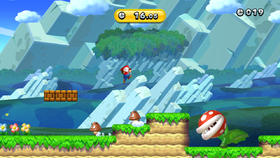
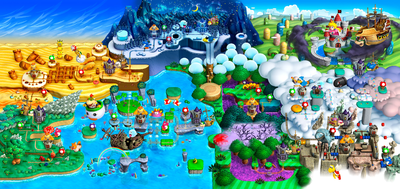
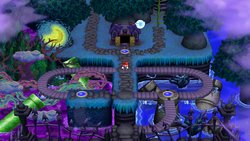


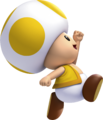
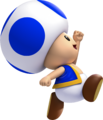
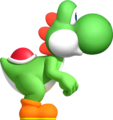
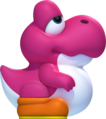
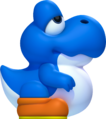

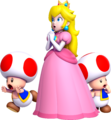

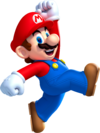
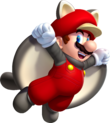
![Artwork of Fire Mario in New Super Mario Bros. (also used in New Super Mario Bros. Wii and Super Mario 3D Land)[1][2]](https://mario.wiki.gallery/images/thumb/8/8a/Fire_Mario.png/185px-Fire_Mario.png)
